Creating a stunning mailbox landscape transforms your home's first impression while adding valuable curb appeal. These 25 carefully selected landscaping ideas offer complete design themes that work with various home styles, climates, and maintenance preferences. From drought-tolerant desert gardens to lush cottage-style plantings, each concept provides a cohesive approach to beautifying your mailbox area. Whether you prefer modern minimalism or rustic charm, seasonal color or year-round structure, these comprehensive designs will help you create an inviting entrance that welcomes visitors and delights passersby. Each idea focuses on complete themes rather than individual elements, ensuring your mailbox becomes a true landscape feature.

1. Native Wildflower Meadow Mailbox Garden
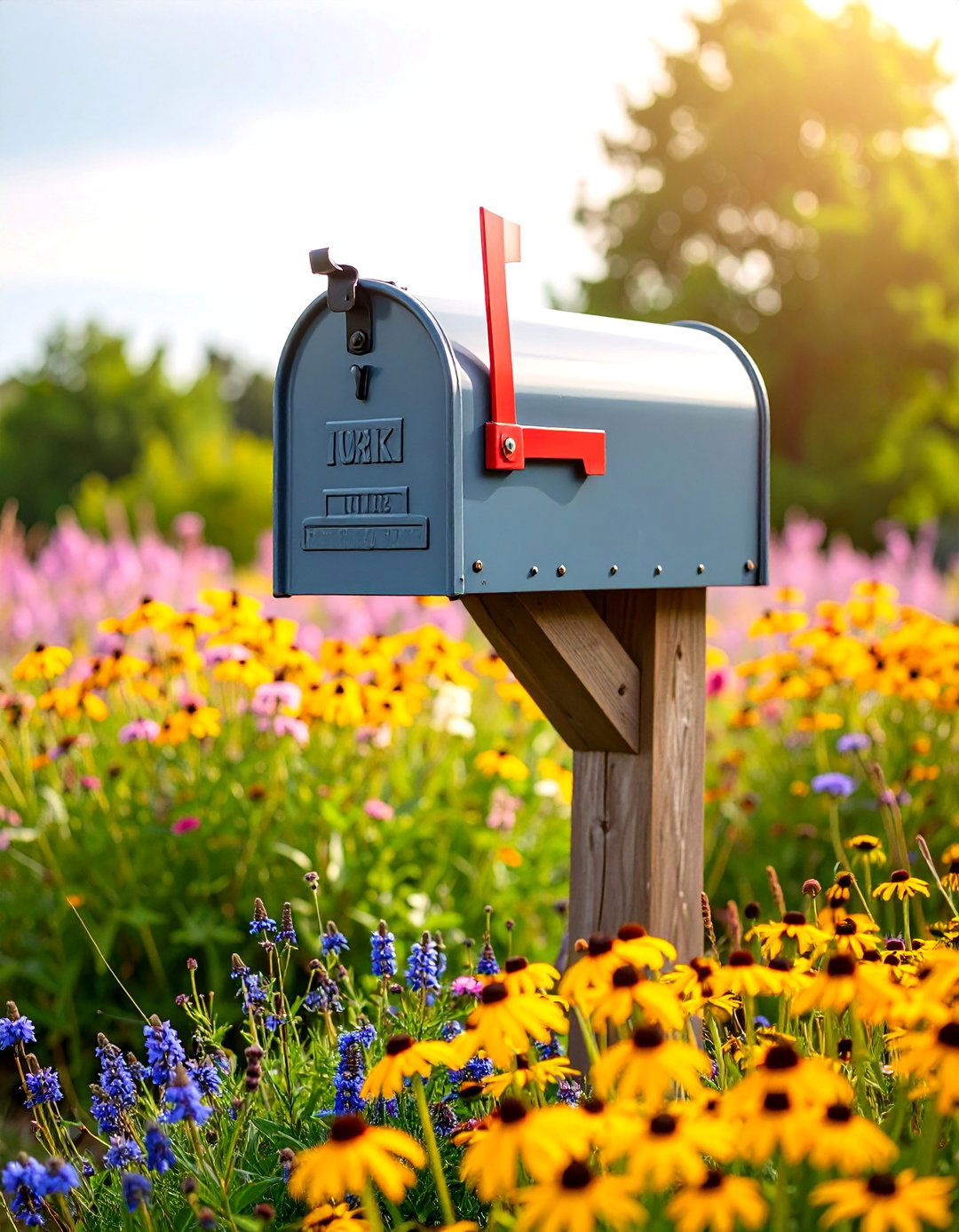
Transform your mailbox area into a miniature prairie ecosystem using indigenous wildflowers and grasses. Plant native species like black-eyed Susans, purple coneflowers, and little bluestem grass to create a natural, informal look. This approach supports local wildlife, requires minimal water once established, and provides changing seasonal interest. The naturalized appearance works perfectly with country or contemporary homes. Choose plants that bloom at different times throughout the growing season to ensure continuous color. Add native sedums and wild bergamot for additional texture and pollinator appeal. This low-maintenance design thrives without fertilizers or frequent watering, making it an environmentally responsible choice that celebrates your region's natural beauty.
2. Perennial Cottage Garden Mailbox Design
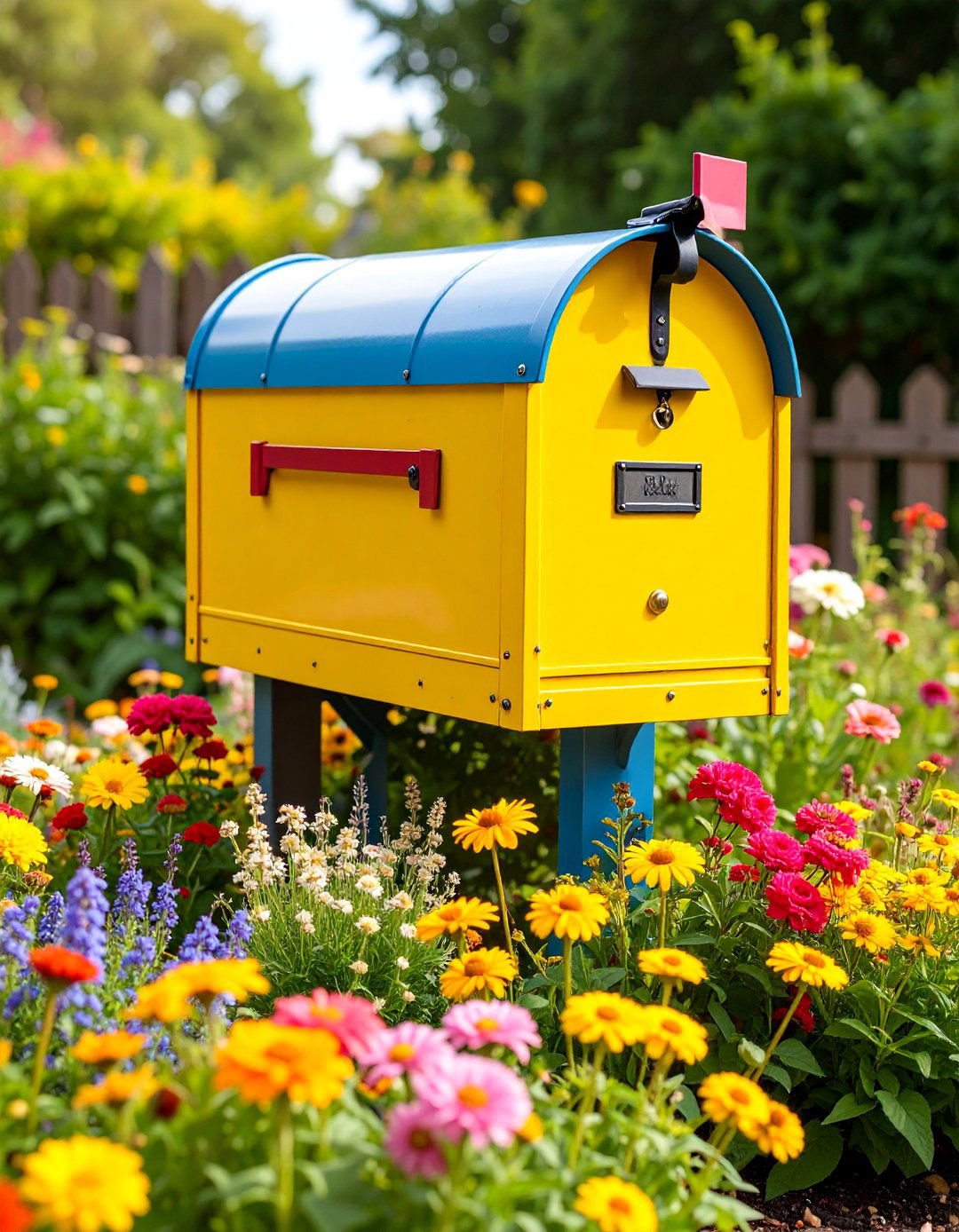
Create a charming English cottage-style garden around your mailbox using a mix of classic perennials. Combine lamb's ear, catmint, and threadleaf coreopsis with delphiniums and sweet alyssum for a romantic, informal look. Layer plants by height, placing shorter varieties at the front and taller specimens behind the mailbox. This design offers year-round structure with seasonal color changes. Include fragrant plants like lavender and sweet peas to engage multiple senses. The cottage garden approach embraces a slightly wild, abundant appearance that softens formal landscapes. Add climbing roses or clematis trained on a simple trellis for vertical interest. This timeless design complements traditional and farmhouse-style homes perfectly.
3. Modern Rock Garden with Ornamental Grasses
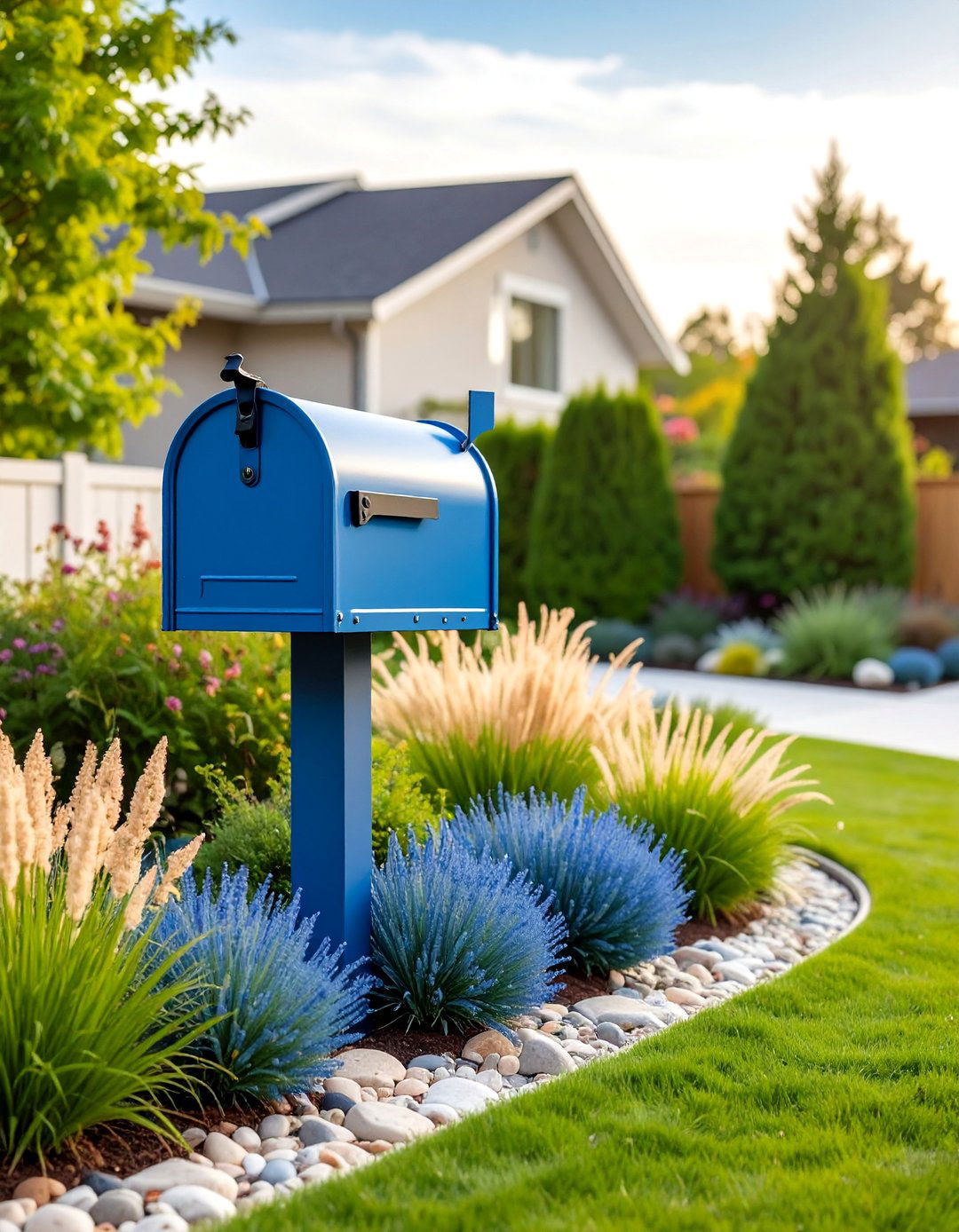
Design a contemporary mailbox landscape using decorative rocks, ornamental grasses, and architectural plants. Combine river rocks of varying sizes with sleek grasses like blue fescue and fountain grass. Add structural elements such as agave or yucca for dramatic focal points. This modern approach requires minimal maintenance while providing year-round visual interest. Use clean lines and geometric patterns to complement contemporary home styles. The neutral color palette of grays, blues, and silvers creates sophisticated curb appeal. Include drought-tolerant perennials like Russian sage or sedum for subtle color. This design works exceptionally well in arid climates and appeals to homeowners seeking water-wise landscaping solutions that don't sacrifice style.
4. Seasonal Color-Changing Mailbox Bed

Plan a dynamic mailbox garden that transforms with each season using strategic plant combinations. Begin with spring bulbs like tulips and daffodils, transition to summer annuals such as petunias and marigolds, then finish with fall mums and ornamental kale. Create a framework using small evergreen shrubs like boxwood or dwarf Alberta spruce for year-round structure. This approach ensures your mailbox area remains attractive throughout the entire year. Plant winter-interest elements such as red-twig dogwood or ornamental grasses that provide texture during dormant months. Include early-blooming perennials like hellebores for late winter color. This comprehensive seasonal approach requires more planning but delivers continuous visual impact that keeps your landscape fresh and engaging.
5. Desert Xeriscaping Mailbox Garden

Embrace water-wise gardening with a desert-inspired mailbox landscape featuring succulents, cacti, and drought-tolerant plants. Combine various agave species, barrel cacti, and colorful sedums with decorative gravel and large accent stones. This design thrives in hot, dry conditions while providing unique architectural interest. Use different textures and forms to create visual complexity without requiring irrigation. Include desert marigolds or brittlebush for seasonal color that complements the sculptural plant forms. The low-maintenance nature makes this perfect for busy homeowners or water-restricted areas. Add colored gravel or decomposed granite pathways to define the space. This striking design works well with Southwestern, modern, or minimalist home styles.
6. Tropical Paradise Mailbox Planting

Create a lush, exotic mailbox garden using bold tropical plants that make a dramatic statement. Incorporate large-leafed plants like elephant ears, cannas, and hibiscus for immediate impact. Add colorful foliage plants such as coleus and caladiums beneath taller specimens. This design creates a vacation-like atmosphere in your front yard. Include fragrant plants like jasmine or gardenia for sensory appeal. The tropical approach works well in warm climates and can be adapted for cooler regions using containers that move indoors during winter. Use bright, saturated colors and varied leaf textures to achieve the lush, abundant look characteristic of tropical landscapes. This bold design complements modern, coastal, or eclectic home styles.
7. Formal Boxwood Border Mailbox Design
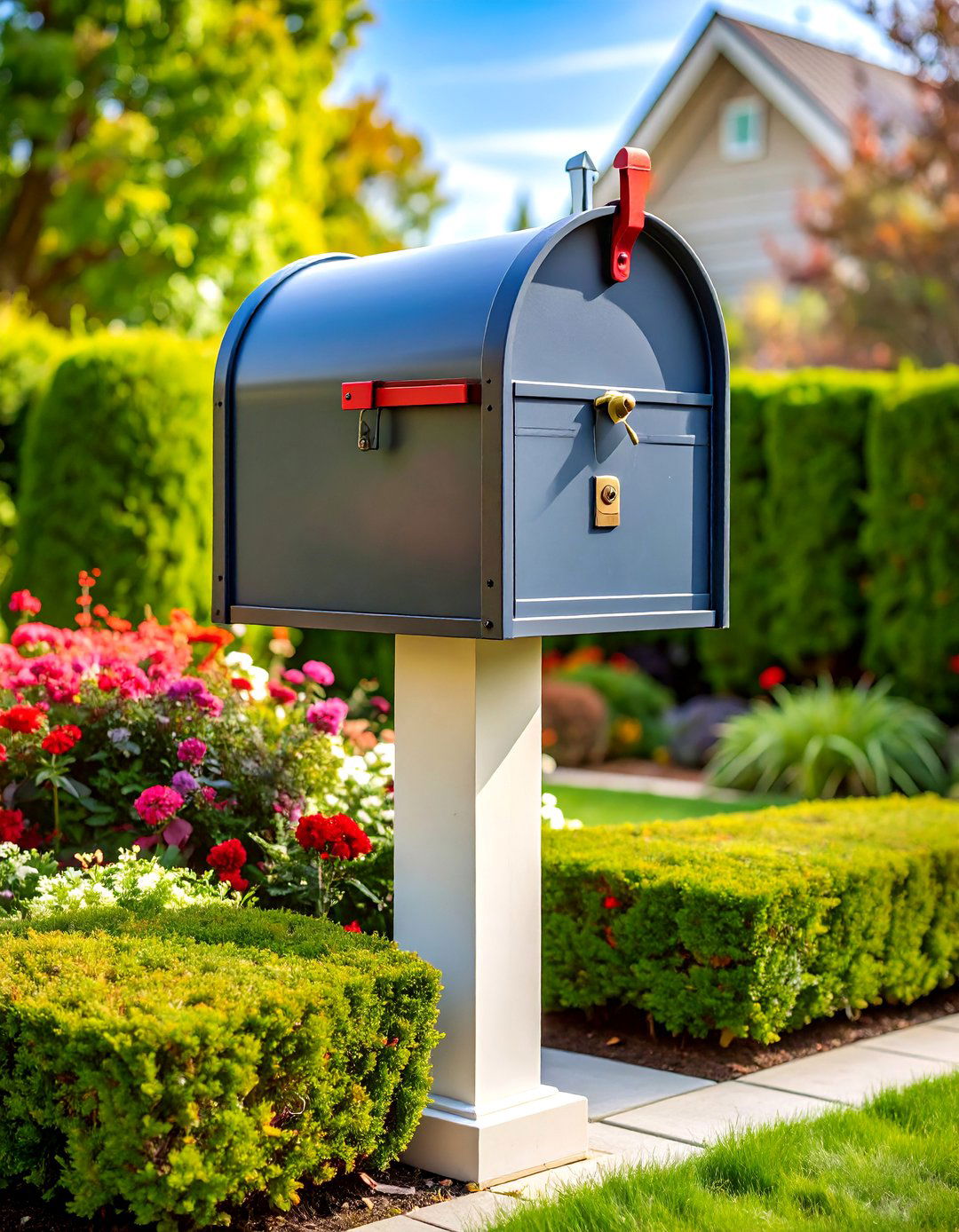
Establish an elegant, structured mailbox garden using neatly trimmed boxwood shrubs and classic plantings. Create symmetrical borders with matching boxwood specimens flanking the mailbox, then add seasonal color with annuals or perennials planted in geometric patterns. This formal approach provides year-round structure and complements traditional home architectures. The clean lines and controlled growth create sophisticated curb appeal that never looks overgrown. Include white or pastel flowers like white petunias or pink begonias for refined color palettes. Add small ornamental trees like dwarf crepe myrtles for height and seasonal interest. This timeless design requires regular pruning but delivers consistently polished results that enhance property values and create welcoming, well-maintained appearances.
8. Rustic Country Mailbox Garden
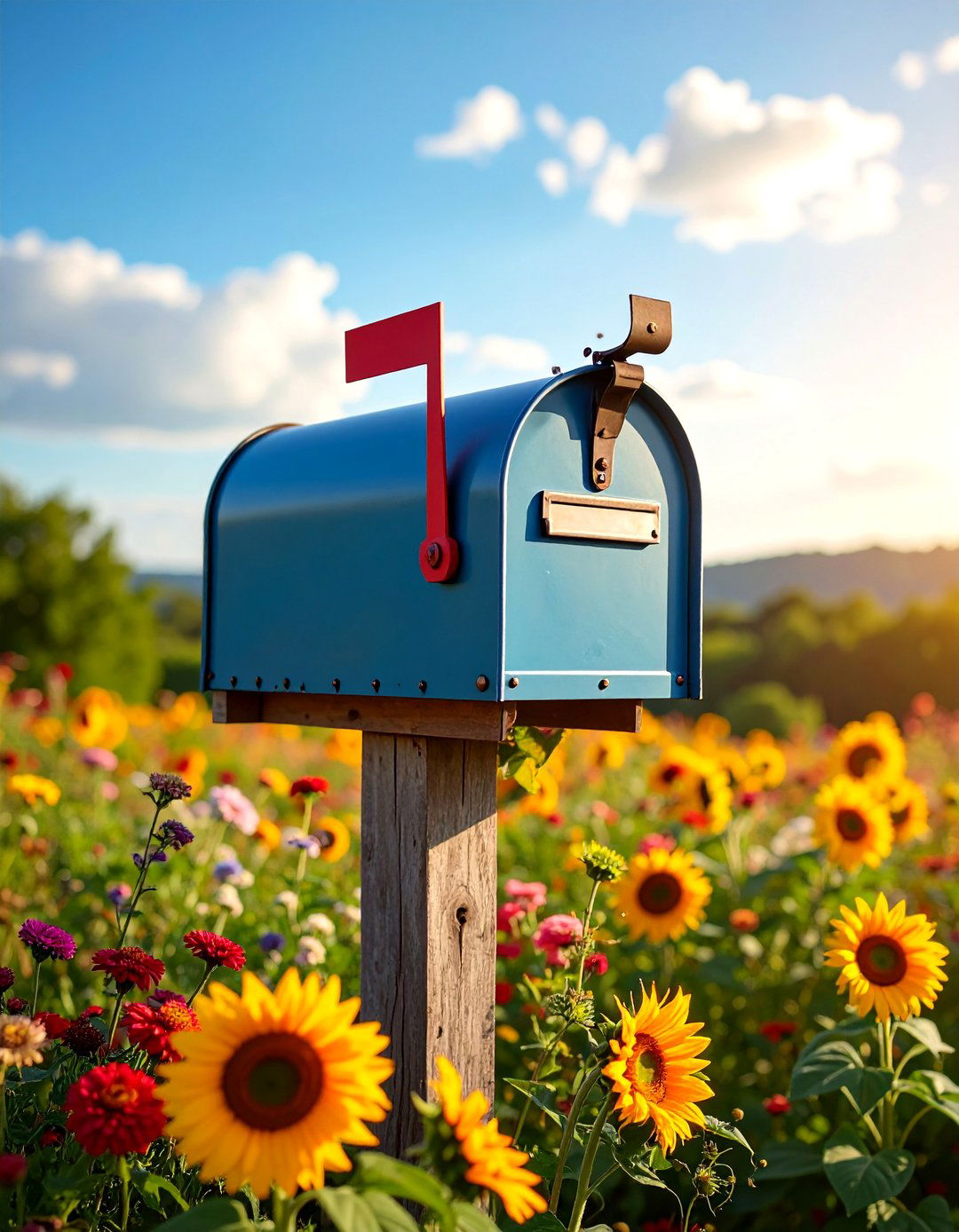
Design a charming country-style mailbox landscape using reclaimed materials and informal plantings. Surround the area with weathered wood edging or old brick borders, then plant a casual mix of sunflowers, zinnias, and cosmos. Include climbing vines like morning glories or sweet peas trained on rustic trellises. This approach celebrates informal beauty and works perfectly with farmhouse or cottage-style homes. Use found objects like old wheelbarrows or watering cans as planters for added character. The country garden style embraces a slightly wild, abundant appearance that feels welcoming and unpretentious. Include herbs like rosemary and thyme for practical beauty. This design requires moderate maintenance while delivering maximum charm and personality.
9. Contemporary Minimalist Mailbox Landscape
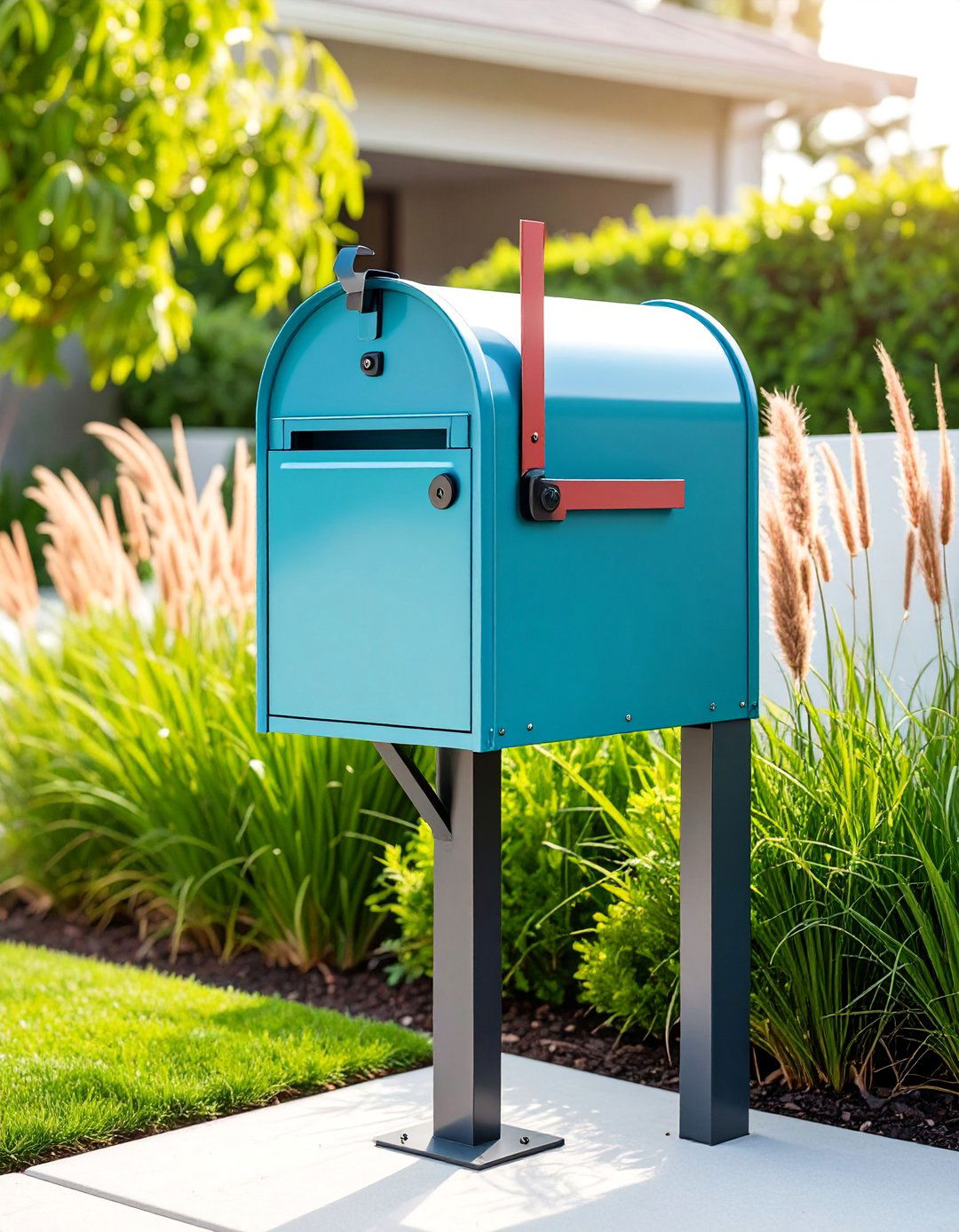
Create a sleek, modern mailbox garden using clean lines, monochromatic color schemes, and architectural plants. Combine ornamental grasses in geometric patterns with minimalist hardscaping elements like steel edging or concrete planters. This sophisticated approach emphasizes form and texture over color. Use plants with strong structural qualities such as spiky yuccas or rounded boxwood spheres. The minimalist design works exceptionally well with contemporary home styles and appeals to homeowners preferring low-maintenance landscapes. Include subtle lighting elements to highlight the design during evening hours. This approach requires precise planning and regular maintenance to preserve clean lines. The resulting effect is sophisticated, timeless, and perfectly suited to modern living requirements.
10. Pollinator-Friendly Butterfly Garden Mailbox

Transform your mailbox area into a wildlife sanctuary using plants specifically chosen to attract butterflies, bees, and beneficial insects. Include native plants like butterfly weed, bee balm, and purple coneflowers that provide nectar throughout the growing season. Add host plants for butterfly larvae such as milkweed for monarchs. This environmentally conscious approach supports local ecosystems while creating beautiful, dynamic landscapes. Include shallow water features or puddling stations for butterfly hydration needs. The constant activity of pollinators adds movement and life to your front yard. Choose plants with varying bloom times to ensure continuous nectar sources. This design requires minimal maintenance once established and provides educational opportunities for children to observe nature's processes up close.
11. Mediterranean Herb Garden Mailbox

Create a fragrant, practical mailbox garden inspired by Mediterranean landscapes using culinary herbs and drought-tolerant plants. Combine rosemary, lavender, thyme, and oregano with silvery-leafed plants like artemisia. This design provides cooking ingredients while creating attractive, low-maintenance landscaping. The Mediterranean approach thrives in sunny, well-drained locations and requires minimal watering once established. Include colorful accents like santolina or salvia for additional visual interest. The fragrant qualities make daily mail retrieval a sensory pleasure. Use gravel mulch and terracotta containers to enhance the Mediterranean aesthetic. This practical design works well with various home styles and appeals to gardening enthusiasts who appreciate functional beauty that serves multiple purposes.
12. Climbing Vine Vertical Mailbox Garden

Maximize vertical space around your mailbox using climbing plants and support structures to create living walls of color. Install trellises, arbors, or wire frameworks behind the mailbox, then plant climbing roses, clematis, or annual vines like morning glories. This approach adds height and drama to small spaces while creating seasonal interest. Choose vines with different bloom times to ensure continuous color throughout the growing season. The vertical elements draw the eye upward and create focal points in otherwise flat landscapes. Include fragrant climbing plants like honeysuckle or jasmine for sensory appeal. This design requires regular pruning and support maintenance but delivers dramatic impact in limited space while providing privacy screening.
13. Container Garden Mailbox Arrangement
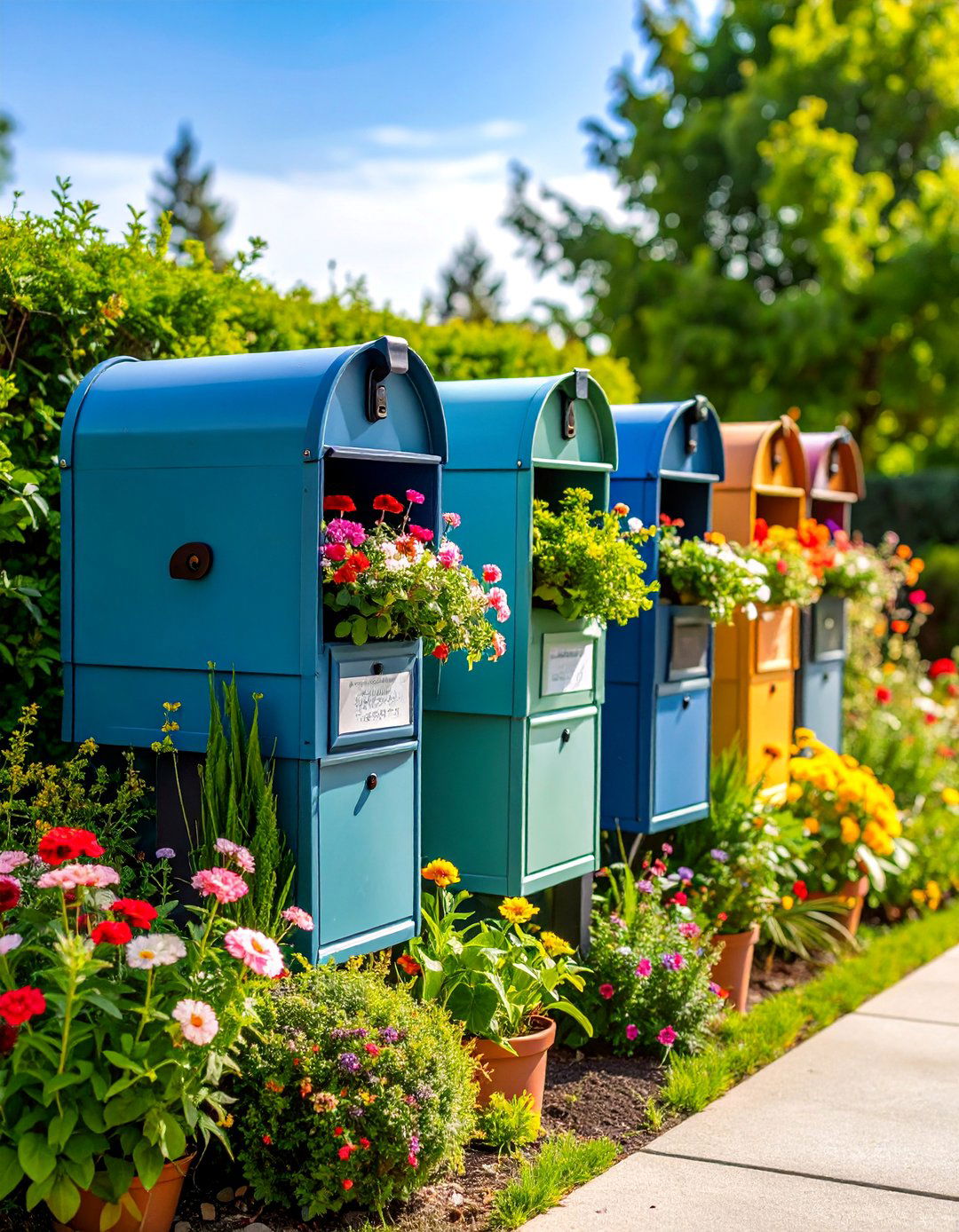
Design a flexible mailbox landscape using various containers and planters that allow seasonal changes and easy maintenance. Combine different pot sizes, materials, and heights to create visual interest without permanent planting. This approach works perfectly for renters or homeowners wanting frequent design changes. Use lightweight containers that can be moved for lawn maintenance or seasonal storage. Include trailing plants like ivy or sweet potato vine to soften container edges. The container approach allows experimentation with plants not suited to local soil conditions. Choose weather-resistant containers in materials like ceramic, fiberglass, or treated wood. This versatile design adapts to any style preference and provides maximum flexibility for creative expression.
14. Stone Border Raised Mailbox Bed

Construct an attractive raised planting bed around your mailbox using natural stone or decorative blocks to create defined garden space. This approach improves drainage, soil quality, and visual impact while making maintenance easier. Fill the raised area with quality soil amendments, then plant a combination of perennials and annuals suited to your climate. The elevated design prevents soil compaction from foot traffic and creates clear boundaries between lawn and garden areas. Include plants of varying heights to create layered visual interest. The stone border adds permanent structure that complements most home styles. This design requires initial construction effort but provides long-term benefits including improved plant health and easier weed control.
15. Ornamental Grass Showcase Mailbox
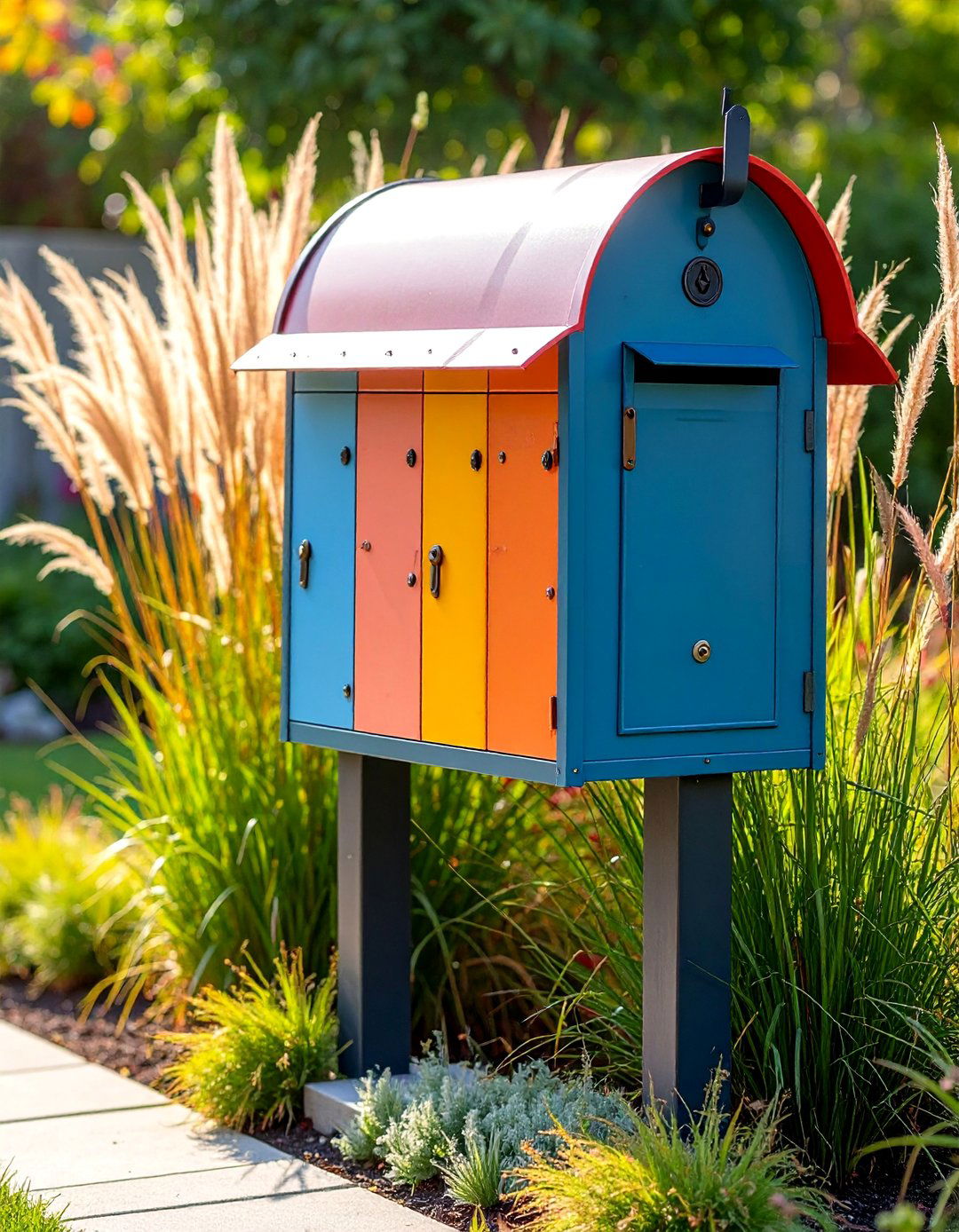
Feature various ornamental grasses as the primary elements in a sophisticated mailbox landscape that provides year-round texture and movement. Combine different grass varieties like feather reed grass, miscanthus, and switchgrass for varying heights and seasonal interest. This approach creates dynamic landscapes that change with weather and seasons. The grasses provide winter interest when many other plants are dormant. Include small flowering perennials like asters or black-eyed Susans for color accents. The low-maintenance nature appeals to busy homeowners while providing sophisticated, naturalistic beauty. Add decorative stone mulch to complement the grass textures. This design works well with contemporary and prairie-style homes while requiring minimal care once established.
16. Cottage Rose Garden Mailbox Design

Create a romantic mailbox landscape centered around fragrant roses and complementary cottage garden plants. Choose compact rose varieties like knock-out roses or miniature climbing roses that won't overwhelm the space. Surround roses with traditional companions like catmint, lady's mantle, and sweet alyssum. This classic combination provides extended blooming periods and timeless appeal. Include bulbs like alliums or tulips for spring interest before roses begin blooming. The cottage garden approach embraces informal planting styles that look naturally abundant rather than strictly controlled. Add fragrant herbs like lavender or thyme to enhance the sensory experience. This romantic design requires regular maintenance including pruning and deadheading but rewards gardeners with continuous blooms and delightful fragrance.
17. Japanese-Inspired Zen Mailbox Garden

Design a peaceful, contemplative mailbox landscape using principles of Japanese garden design including asymmetrical balance and natural materials. Incorporate elements like ornamental grasses, dwarf conifers, and carefully placed stones to create serene compositions. This approach emphasizes texture, form, and seasonal subtlety over bright colors. Include plants like Japanese forest grass, dwarf Japanese maple, or mugo pine for authentic aesthetics. The zen garden style promotes meditation and mindfulness through simple, elegant design elements. Use fine gravel or moss as ground cover to maintain clean, uncluttered appearances. This sophisticated design requires thoughtful plant placement and regular maintenance to preserve the intended peaceful atmosphere.
18. Edible Landscape Mailbox Garden
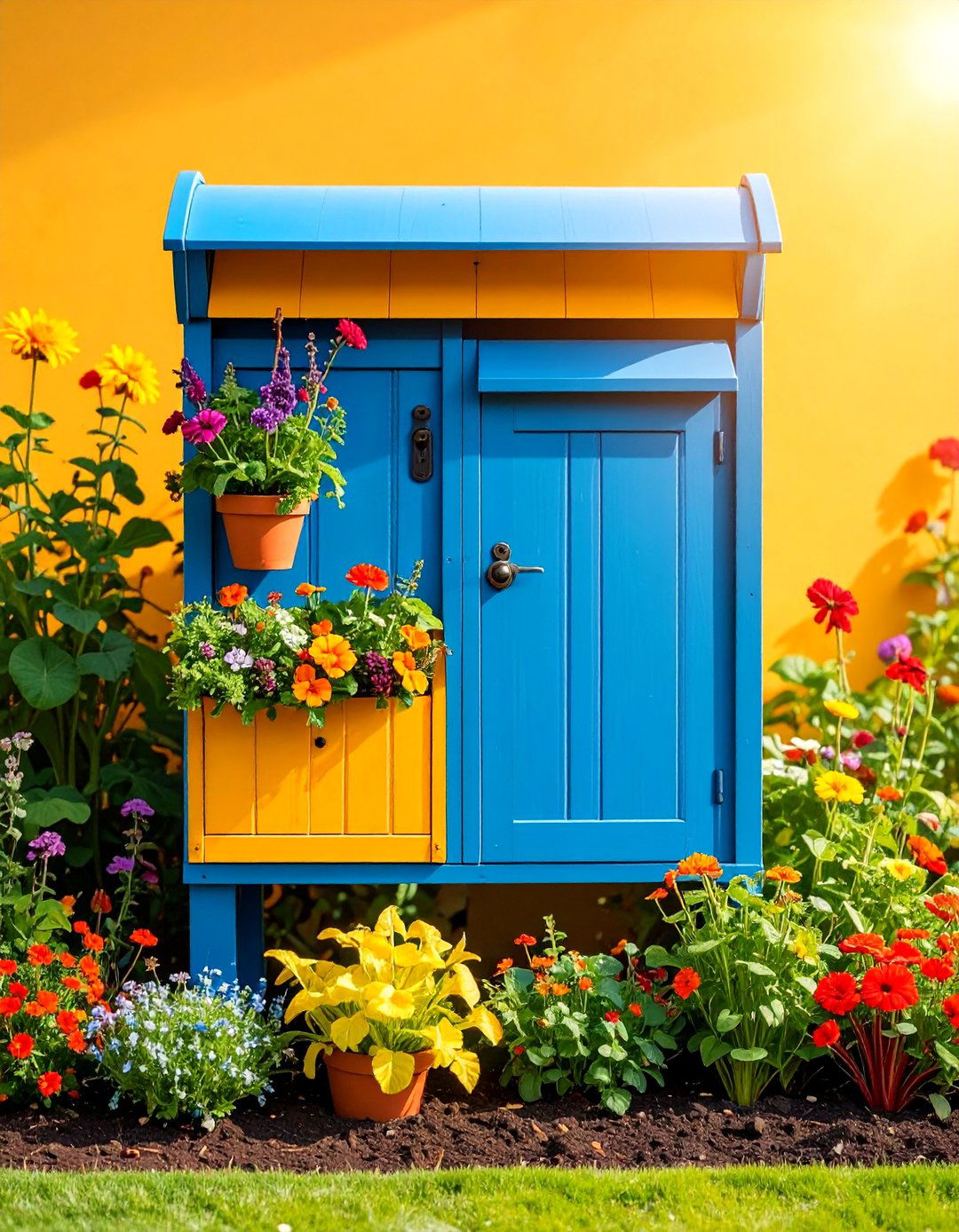
Combine beauty with functionality by creating an edible mailbox landscape using ornamental vegetables, herbs, and fruit plants. Include decorative varieties like rainbow chard, purple kale, and colorful lettuce alongside traditional herbs. This approach provides fresh ingredients while maintaining attractive curb appeal. Choose edible flowers like nasturtiums or calendulas for additional color and culinary uses. The edible landscape concept appeals to sustainable living enthusiasts and families wanting to involve children in gardening. Include compact fruit plants like dwarf berry bushes or small citrus trees where climate permits. This practical design requires regular harvesting to maintain appearance but provides ongoing rewards beyond visual beauty.
19. Wildflower Prairie Mailbox Meadow
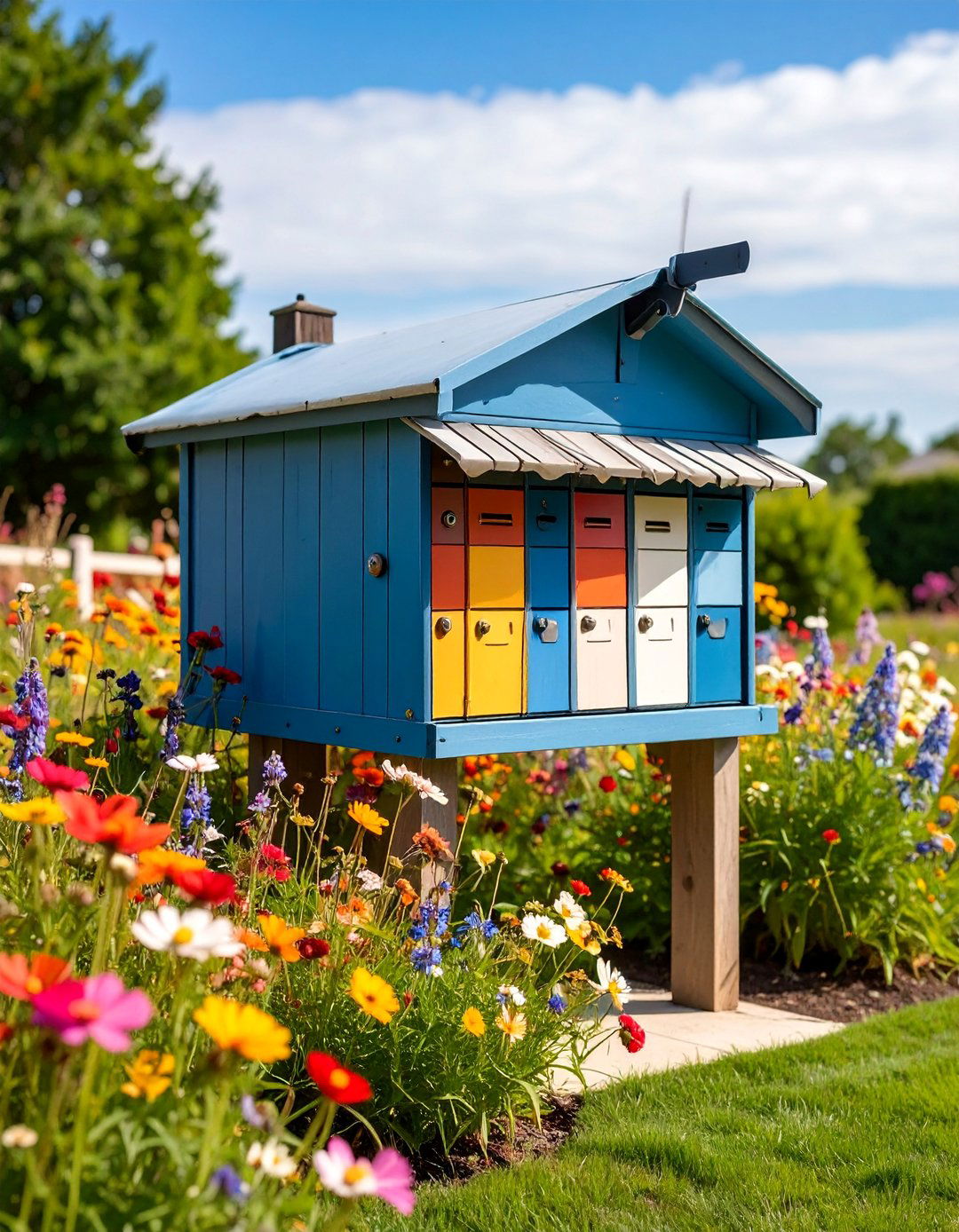
Establish a naturalistic mailbox landscape using native wildflower mixes that create seasonal prairie-like environments. Sow mixtures appropriate to your region including species like cosmos, larkspur, and native grasses. This low-maintenance approach supports local ecosystems while providing changing seasonal displays. The informal, natural appearance works well with country or contemporary home styles. Include perennial wildflowers that return annually alongside self-seeding annuals for continuous variety. This design requires minimal intervention once established and provides habitat for beneficial insects and birds. The meadow approach celebrates regional plant communities while creating unique, ever-changing landscapes that never look exactly the same from year to year.
20. Barrel Planter Rustic Mailbox
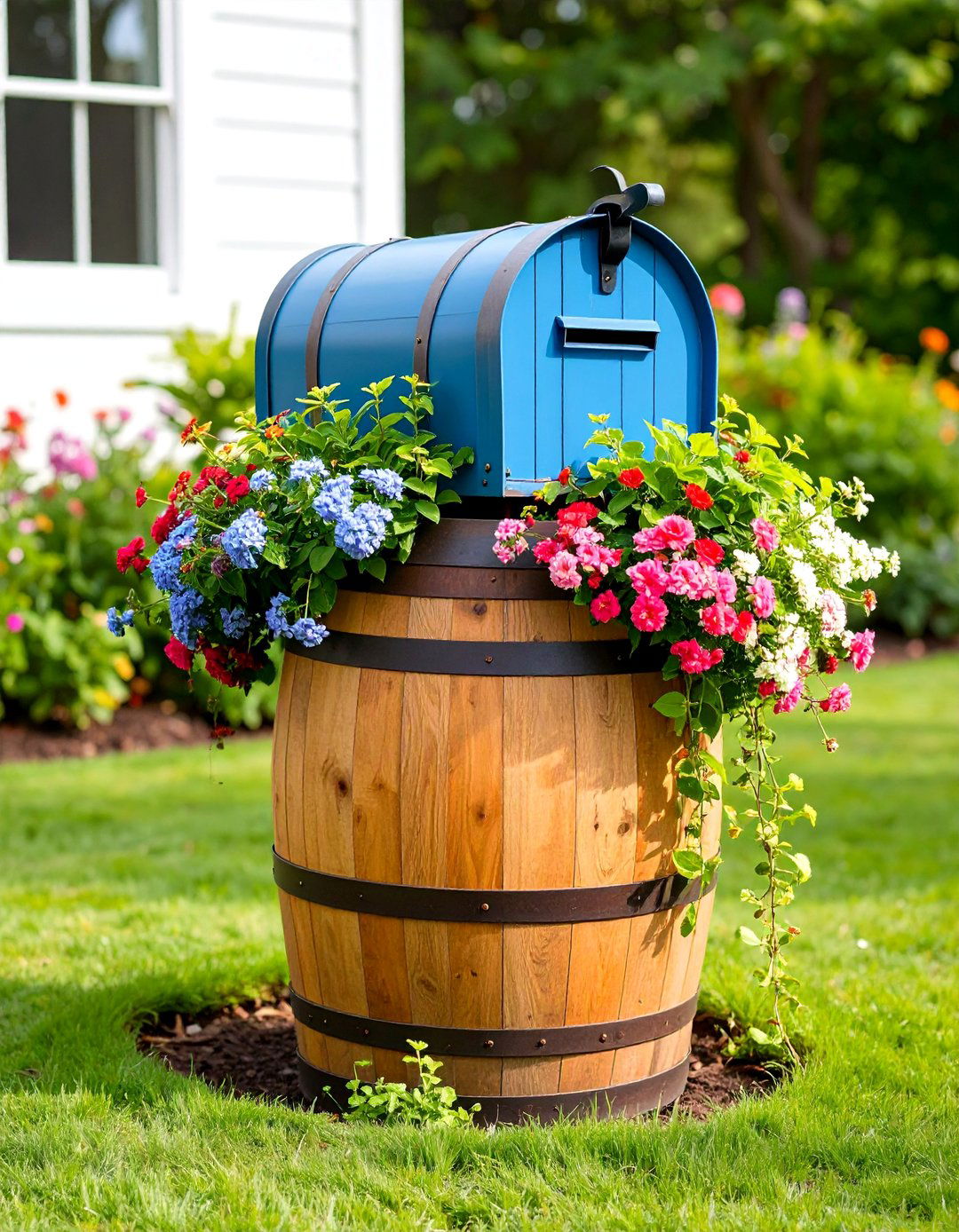
Repurpose large wooden barrels or similar containers to create charming rustic mailbox planters that add character and functionality. Plant the barrels with seasonal flowers, trailing vines, or mixed combinations that complement your home's style. This approach provides instant impact while allowing flexibility for seasonal changes. The rustic container style works particularly well with farmhouse, cottage, or country-themed landscapes. Include drainage holes and quality potting soil to ensure plant health. Choose plants with varying textures and growth habits to create full, abundant displays. This container approach allows gardening in areas with poor soil while creating focal points that can be moved or replanted as needed.
21. Succulent Rock Garden Mailbox
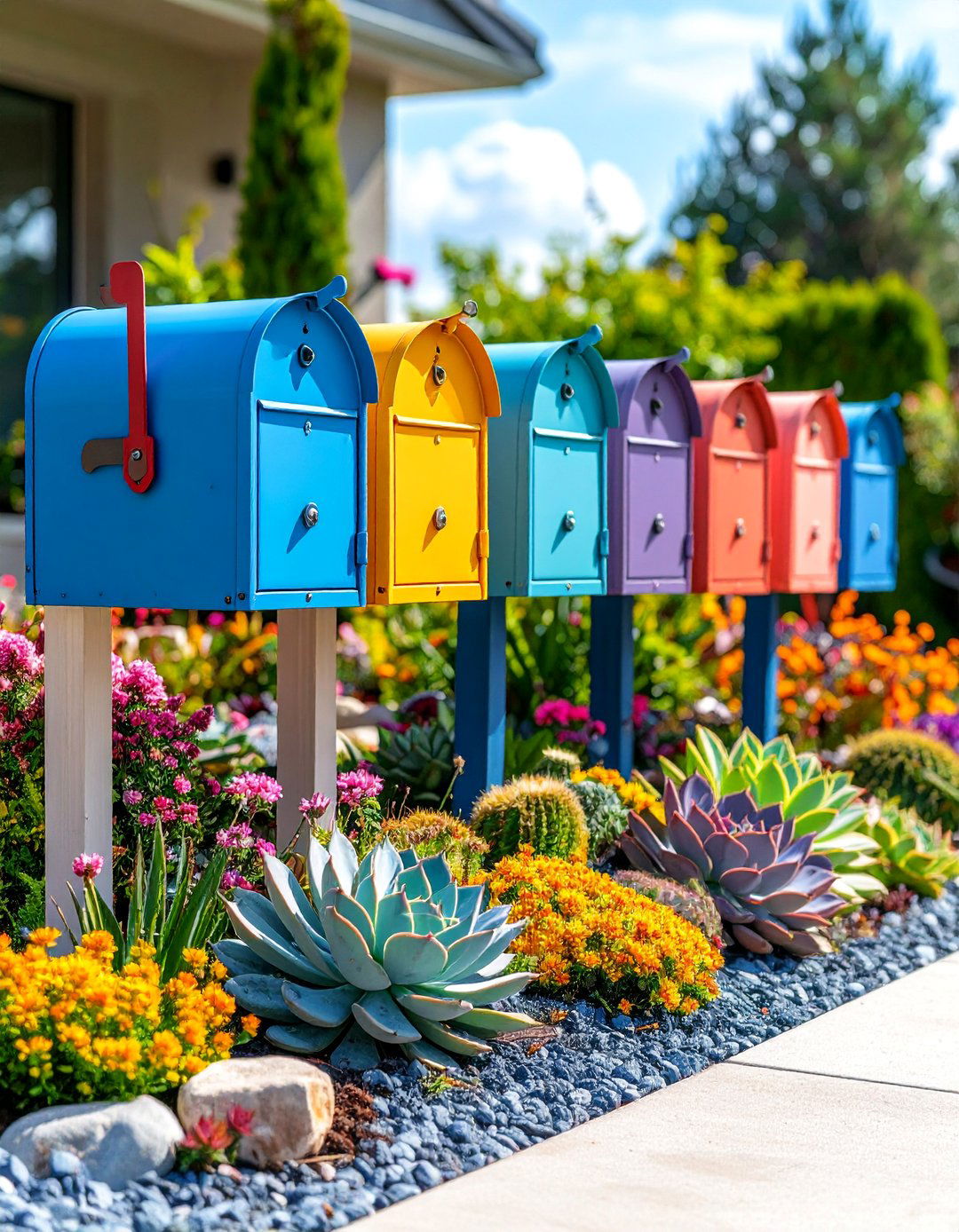
Design a water-wise mailbox landscape featuring diverse succulent varieties arranged among decorative rocks and gravel. Combine different succulent forms, colors, and textures including hen-and-chicks, echeveria, and sedum varieties. This approach thrives in sunny, well-drained locations while requiring minimal maintenance. The architectural plant forms create year-round interest without seasonal dieback. Include larger accent rocks or boulders to add scale and visual weight. The succulent garden approach appeals to modern design sensibilities while providing drought tolerance. Use different colored gravels or decomposed granite to create patterns and define planting areas. This contemporary design works well with modern, southwestern, or minimalist home styles while requiring very little ongoing care.
22. Mixed Border Perennial Mailbox Garden

Create a classic mixed border around your mailbox using carefully selected perennials that provide successive blooms throughout the growing season. Layer plants by height and bloom time to ensure continuous color and interest. Include early bloomers like hellebores, mid-season performers like daylilies, and late-season stars like asters. This traditional approach provides reliable beauty with manageable maintenance requirements. Choose plants with complementary color schemes and varying textures to create sophisticated compositions. Include evergreen elements like small shrubs or ornamental grasses for winter structure. This time-tested design approach works with most home styles and provides long-term value through perennial establishment and reduced replanting needs.
23. Coastal Beach Theme Mailbox Garden

Design a beach-inspired mailbox landscape using plants and materials that evoke coastal environments. Include salt-tolerant plants like beach grass, rosa rugosa, and lavender combined with weathered wood elements and smooth stones. This theme works well for coastal properties or inland homes wanting beach aesthetics. Use blue and white color schemes with silver-leafed plants to suggest ocean and sky. Include decorative elements like driftwood, shells, or nautical accessories for authentic coastal appeal. The beach garden approach emphasizes informal, wind-swept appearances that suggest natural seaside environments. Choose plants that tolerate sandy soil and salt spray if near actual coastlines.
24. Formal Geometric Mailbox Design

Create an elegant, structured mailbox landscape using geometric patterns and formal plant arrangements. Design circular, square, or triangular planting beds with precise edges and symmetrical plant placement. This approach works well with traditional or colonial home styles that emphasize formal landscaping principles. Use low-growing, compact plants that maintain their shape like boxwood, dwarf barberry, or neat perennials. Include seasonal color through carefully planned annual plantings or bulb displays. The formal approach requires regular maintenance including pruning and edge trimming but creates sophisticated, polished results. Add pathway materials like brick or stone to enhance the formal aesthetic while providing clear access to the mailbox.
25. Railroad Tie Raised Mailbox Garden
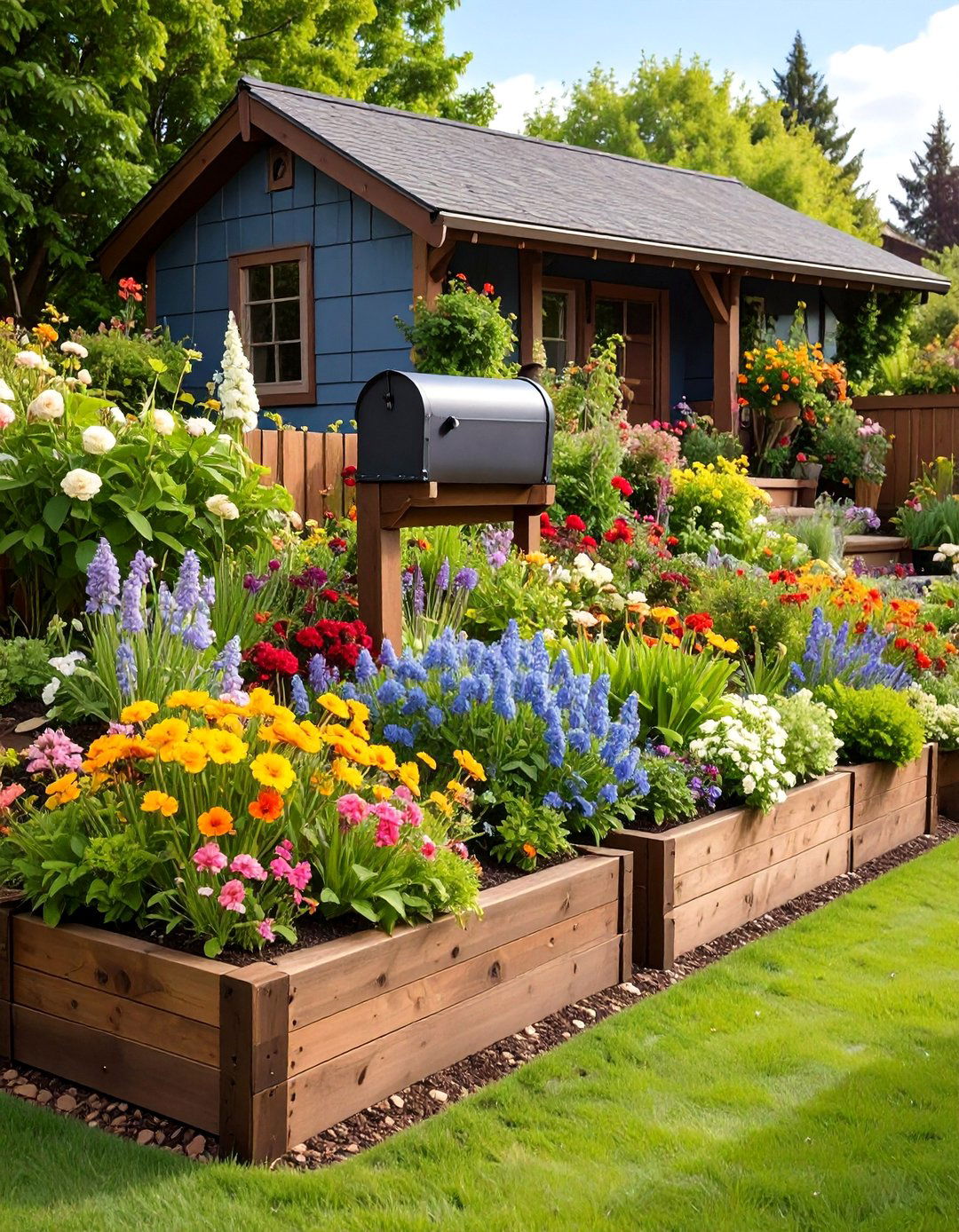
Construct an attractive raised planting bed using railroad ties or similar timber materials to create substantial, rustic mailbox landscaping. This approach provides excellent drainage, defined planting space, and visual weight that anchors the mailbox area. Fill the raised bed with quality soil amendments and plant combinations suitable to your climate and preferences. The substantial timber construction complements craftsman, farmhouse, or rustic home styles while providing practical gardening benefits. Include plants of varying heights to create visual interest within the defined space. This design requires initial construction effort but provides long-term structure and improved growing conditions that benefit plant health and garden maintenance.
Conclusion:
These 25 mailbox landscaping ideas demonstrate how thoughtful design can transform an ordinary functional element into a stunning landscape feature. Whether you prefer low-maintenance native plants, colorful seasonal displays, or structured formal gardens, there's an approach suited to your style, climate, and maintenance preferences. Remember to consider practical factors like mail carrier access, visibility, and local regulations when implementing your chosen design. With proper planning and plant selection, your mailbox garden will enhance curb appeal, express personal style, and provide years of beauty and enjoyment.





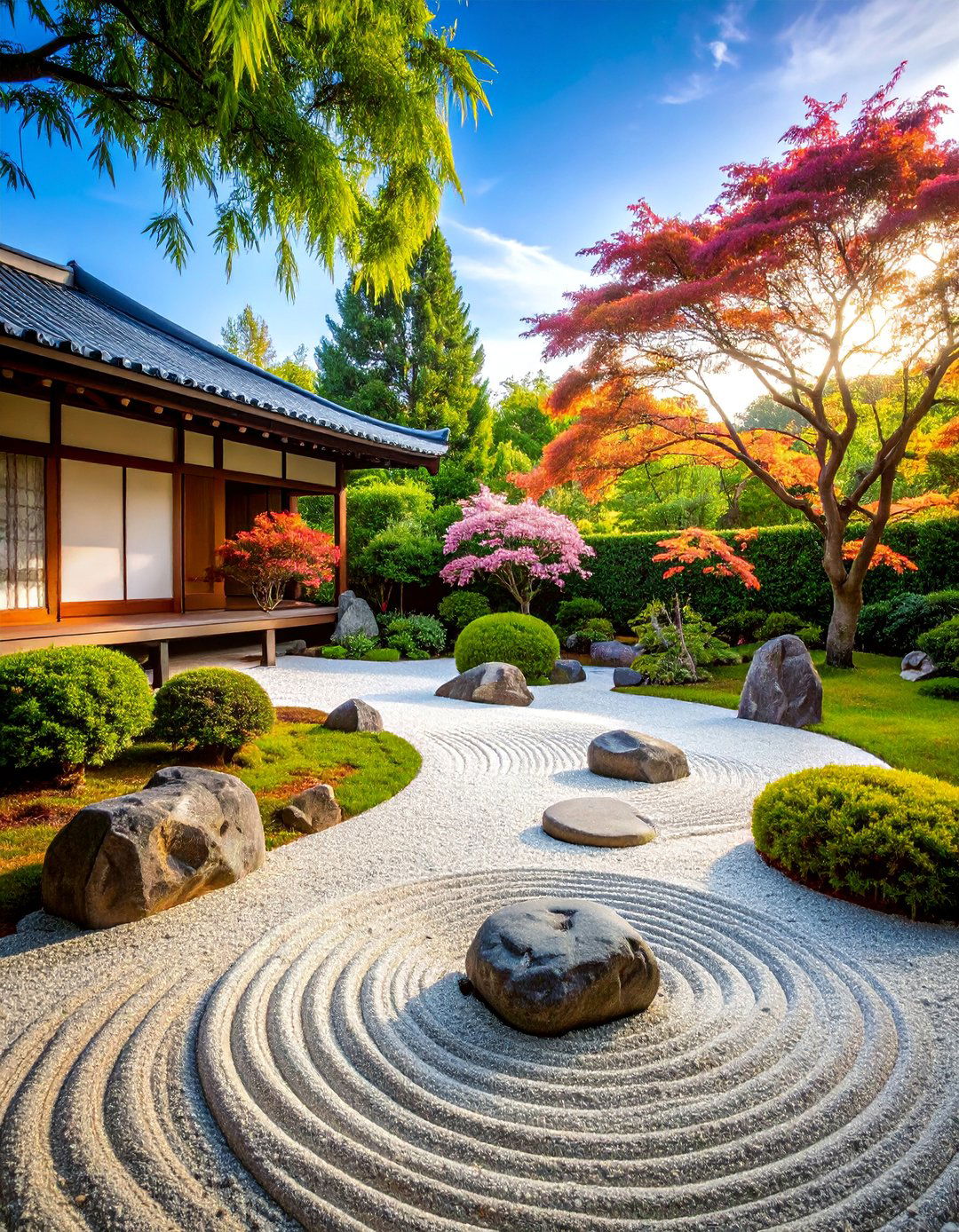
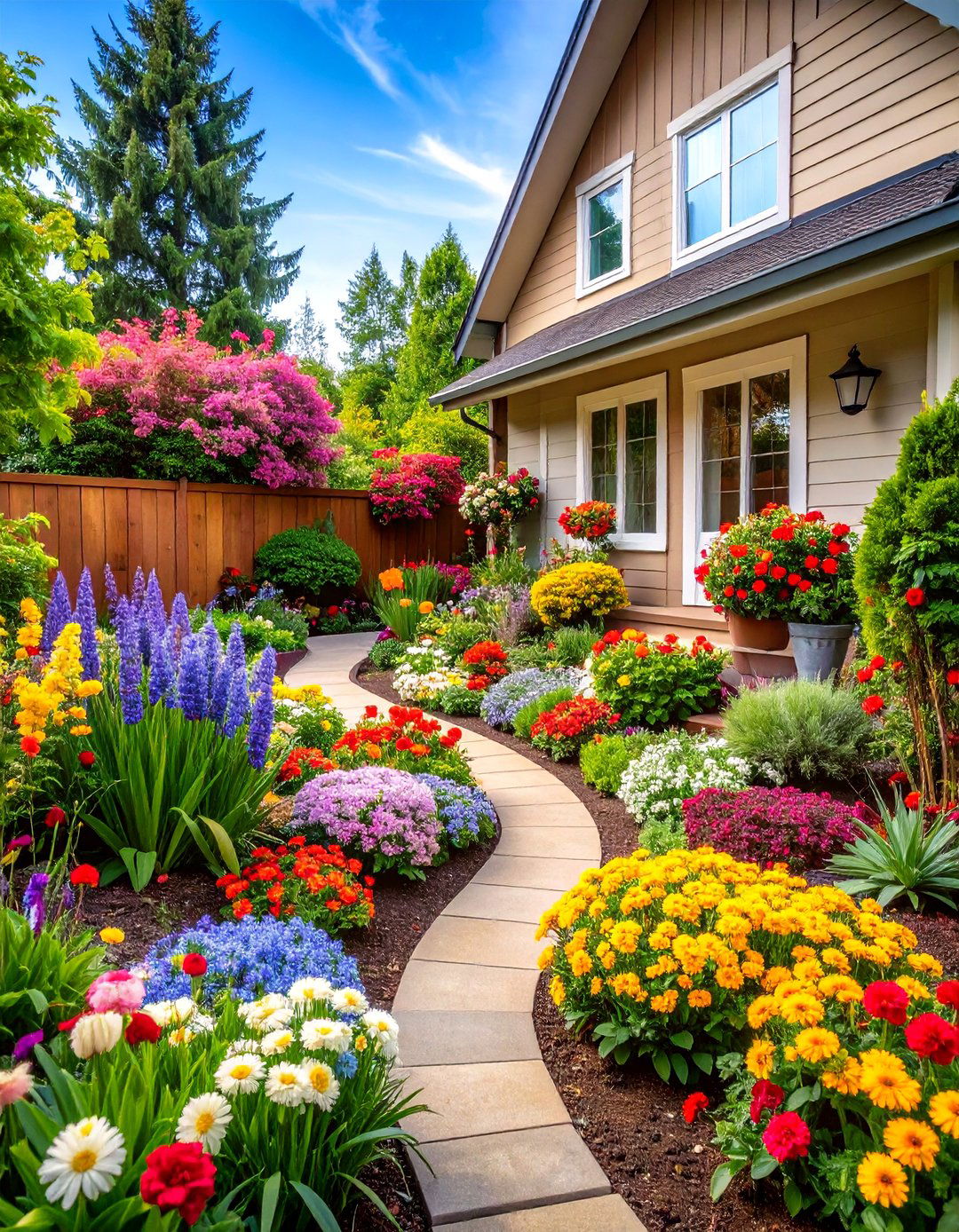
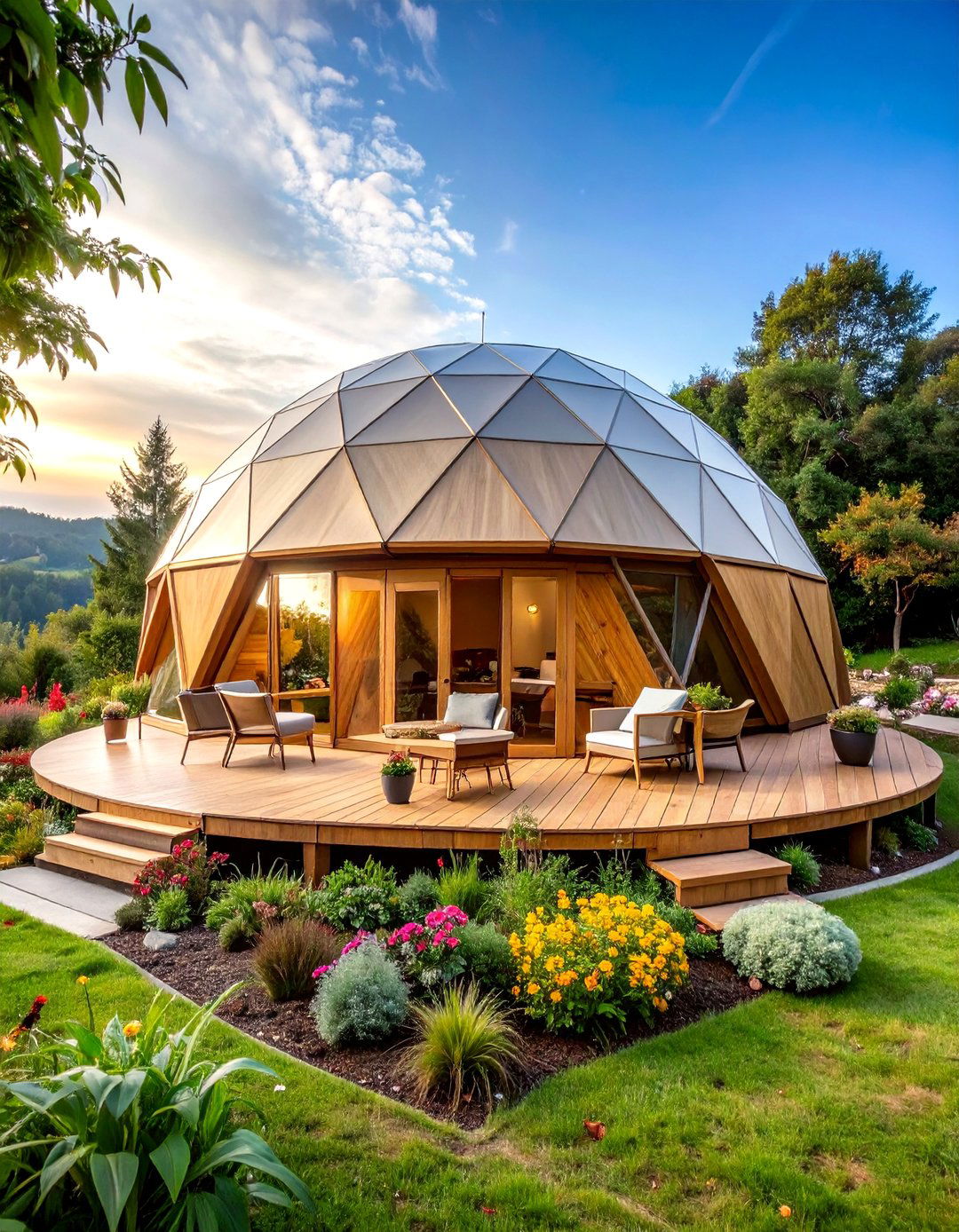


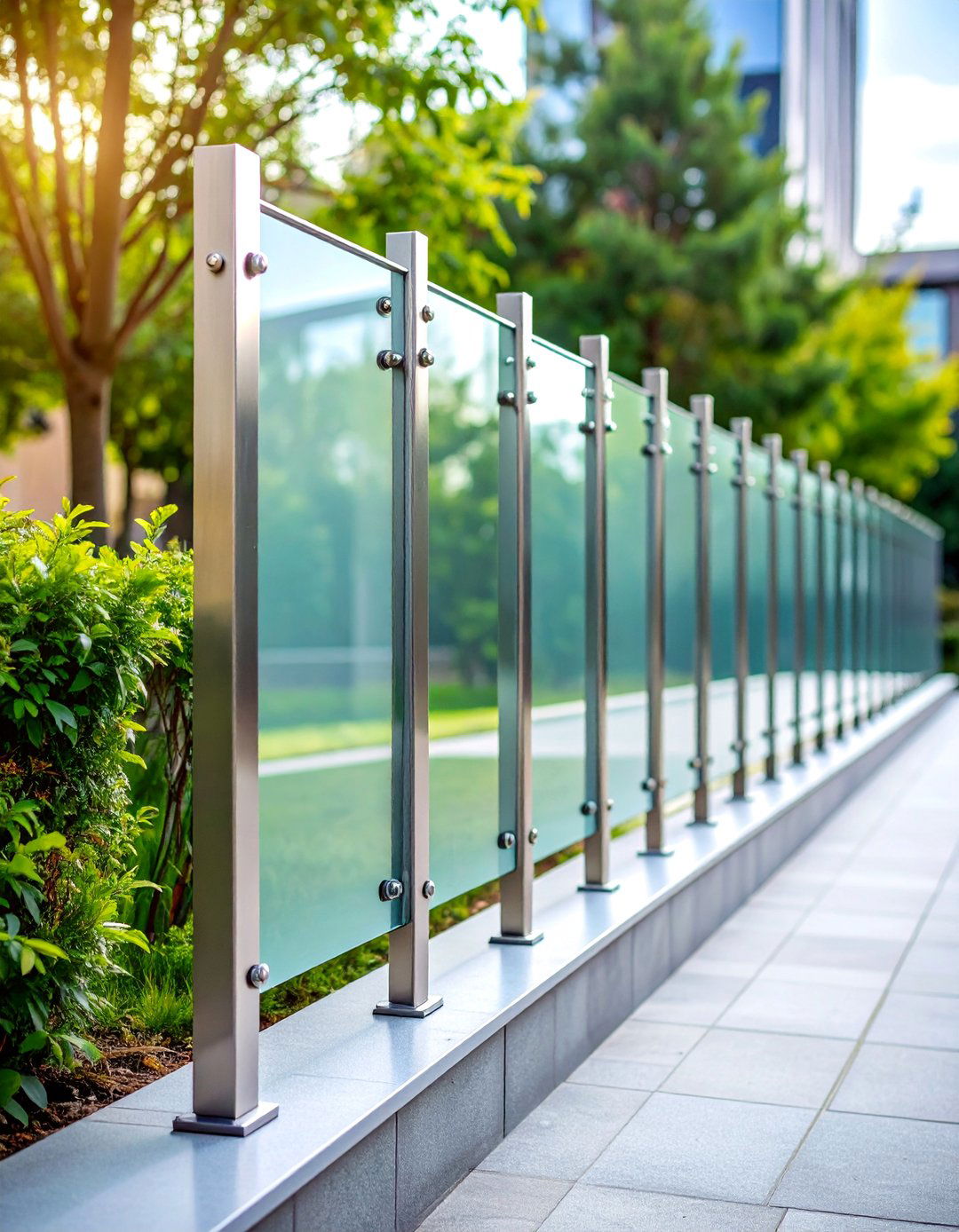



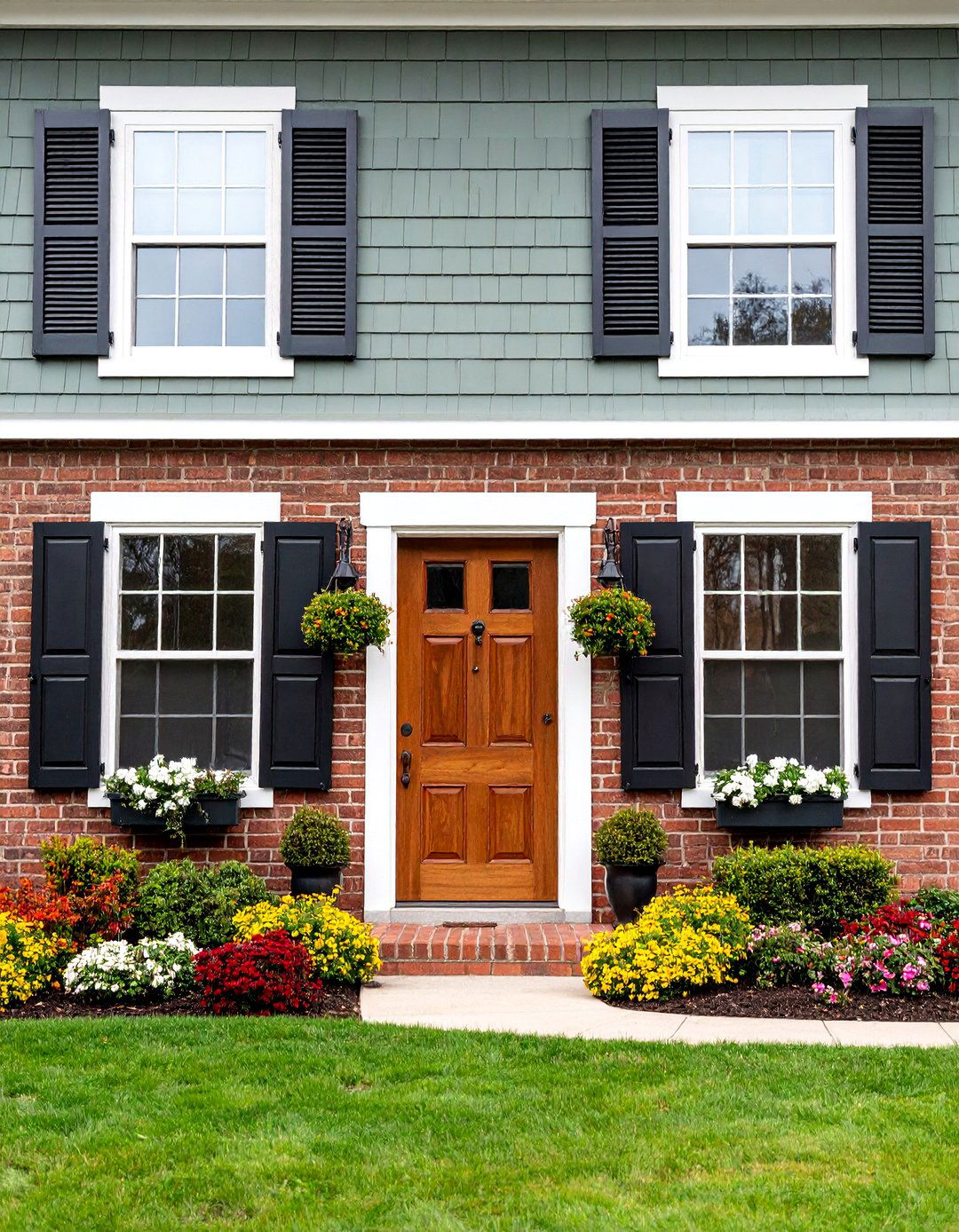
Leave a Reply